100 Picosecond/Sub-10−17 Level GPS Differential Precise Time and Frequency Transfer
Abstract
:1. Introduction
2. Differential Precise Time and Frequency Transfer
2.1. Double-Difference Fixed Ambiguity Resolution
2.2. Single-Difference Ambiguity Estimation
2.3. Time Difference Estimation of DPT
3. Experiment Strategy
4. Single-Difference Ambiguity Analysis
5. DPT Time and Frequency Transfer Validations
5.1. DPT Time Transfer in a Common Clock
5.2. DPT Time Transfer Validations with Closure Baselines
5.3. Long-Term DPT Time and Frequency Transfer Validations
6. Discussion
7. Conclusions
Author Contributions
Funding
Institutional Review Board Statement
Informed Consent Statement
Data Availability Statement
Acknowledgments
Conflicts of Interest
References
- Feng, Y.; Li, B. Four dimensional real time kinematic state estimation and analysis of relative clock solutions. In Proceedings of the 23rd International Technical Meeting of the Satellite Division of the Institute of Navigation (ION GNSS 2010), Portland, OR, USA, 21–24 September 2010. [Google Scholar]
- Allan, D.W.; Weiss, M.A. Accurate time and frequency transfer during common-view of a GPS satellite. In Proceedings of the 34th Annual Symposium on Frequency Control, Philadelphia, PA, USA, 28–30 May 1980. [Google Scholar]
- Tu, R.; Zhang, P.; Zhang, R.; Fan, L.; Han, J.; Hong, J.; Liu, J.; Lu, X. Real-time and dynamic time transfer method based on double-differenced real-time kinematic mode. IET Radar Sonar Navig. 2021, 15, 143–153. [Google Scholar] [CrossRef]
- Weiss, M.A.; Petit, G.; Jiang, Z. A comparison of GPS common-view time transfer to all-in-view. In Proceedings of the 2005 IEEE International Frequency Control Symposium and Exposition, Vancouver, BC, Canada, 29–31 August 2005. [Google Scholar]
- Jiang, Z. Time transfer with GPS satellites all in view. In Proceedings of the Asia-Pacific Workshop on Time and Frequency (ATF2004), Beijing, China, 18–19 October 2004. [Google Scholar]
- Petit, G.; Jiang, Z. GPS All in View time transfer for TAI computation. Metrologia 2008, 45, 35. [Google Scholar] [CrossRef]
- AurHarmegnies, É.; Defraigne, P.; Petit, G. Combining GPS and GLONASS in all-in-view for time transfer. Metrologia 2013, 50, 277–287. [Google Scholar] [CrossRef]
- Delporte, J.; Mercier, F.; Laurichesse, D.; Galy, O. Fixing integer ambiguities for GPS carrier-phase time transfer. In Proceedings of the 2007 IEEE International Frequency Control Symposium Joint with the 21st European Frequency and Time Forum, Geneva, Switzerland, 29 May–1 June 2007. [Google Scholar]
- Schildknecht, T.; Dach, R.; Bock, H. GPS phase measurements for high-precision time and frequency transfer. IEEE Trans. Instrum. Meas. 1995, 44, 634–638. [Google Scholar]
- Zumberge, J.F.; Heflin, M.B.; Jefferson, D.C.; Watkins, M.M.; Webb, F.H. Precise point positioning for the efficient and robust analysis of GPS data from large networks. J. Geophys. Res. Solid Earth 1997, 102, 5005–5017. [Google Scholar] [CrossRef]
- Orgiazzi, D.; Tavella, P.; Lahaye, F. Experimental assessment of the time transfer capability of Precise Point Positioning (PPP). In Proceedings of the 2005 IEEE International Frequency Control Symposium and Exposition, Vancouver, BC, Canada, 29–31 August 2005. [Google Scholar]
- Gu, S.; Wang, K.; Gong, Y. Time and frequency transfer using GNSS: Principles, algorithms, and experiments. GPS Solut. 2019, 23, 38. [Google Scholar]
- Delporte, J.; Mercier, F.; Laurichesse, D.; Galy, O. GPS carrier-phase time transfer using single difference integer ambiguity resolution. Int. J. Navig. Obs. 2008, 2008, 273785. [Google Scholar] [CrossRef]
- Lee, S.W.; Schutz, B.E.; Lee, C.-B.; Yang, S.H. A study on the common-view and all-in-view GPS time transfer using carrier-phase measurements. Metrologia 2008, 45, 156. [Google Scholar] [CrossRef]
- Teunissen, P.J.G. A New Method for Fast Carrier Phase Ambiguity Estimation. In Proceedings of the 1994 IEEE Position, Location and Navigation Symposium—PLANS’94, Las Vegas, NV, USA, 11–15 April 1994; pp. 562–573. [Google Scholar]
- Odolinski, R.; Teunissen, P.J.G.; Odijk, D. Combined BDS, Galileo, QZSS and GPS single-frequency RTK. GPS Solut. 2015, 19, 151–163. [Google Scholar] [CrossRef]
- Gong, X.; Lou, Y.; Liu, W.; Zheng, F.; Gu, S.; Wang, H. Rapid ambiguity resolution over medium-to-long baselines based on GPS/BDS multi-frequency observables. Adv. Space Res. 2016, 59, 794–803. [Google Scholar] [CrossRef]
- Hou, P.; Zhang, B.; Liu, T. Integer-estimable glonass fdma model as applied to kalman-filter-based short- to long-baseline rtk positioning. GPS Solut. 2020, 24, 93. [Google Scholar] [CrossRef]
- Teunissen, P.J. An optimality property of the integer leastsquares estimator. J. Geod. 1999, 73, 587–593. [Google Scholar] [CrossRef]
- Krishna, K.; Murty, M.N. Genetic K-Means Algorithm. IEEE Trans. Cybern. 1999, 29, 433–439. [Google Scholar] [CrossRef] [PubMed]
- Ding, C.; He, X. K-means clustering via principal component analysis. In Proceedings of the Twenty-First International Conference on Machine Learning, Banff, AB, Canada, 4–8 July 2004. [Google Scholar]
- Counselman, C.C., II. Differential GPS and its application to geodynamics. J. Geophys. Res. Solid Earth 1988, 93, 14317–14326. [Google Scholar]
- Odolinski, R.; Teunissen, P.J.G.; Odijk, D. Combined GPS+ BDS for short to long baseline RTK positioning. Meas. Sci. Technol. 2015, 26, 045801. [Google Scholar] [CrossRef]
- Li, Z.; Huang, J. GPS Surveying and Data Processing, 2nd ed.; Wuhan University Press: Wuhan, China, 2010. [Google Scholar]
- Cui, B.; Li, P.; Wang, J.; Ge, M.; Schuh, H. Calibrating receiver-type-dependent wide-lane uncalibrated phase delay biases for PPP integer ambiguity resolution. J. Geod. 2021, 95, 82. [Google Scholar] [CrossRef]
- Available online: https://webtai.bipm.org/database/ (accessed on 1 May 2023).
- Petit, G.; Jiang, Z.; White, J.; Beard, R.; Powers, E. Absolute Calibration of an Ashtech Z12-T GPS Receiver. GPS Solut. 2001, 4, 41–46. [Google Scholar] [CrossRef]
- Available online: https://igs.org/products/ (accessed on 25 May 2023).
- Allan, D.W. A modified Allan variance with increased oscillator characterization ability. In Proceedings of the Thirty Fifth Annual Frequency Control Symposium, Philadelphia, PA, USA, 27–29 May 1981. [Google Scholar]
- Allan, W.D.; Weiss, M.A.; Jespersen, J.L. A frequency-domain view of time-domain characterization of clocks and time and frequency distribution systems. In Proceedings of the 45th Annual Symposium on Frequency Control 1991, Los Angeles, CA, USA, 29–31 May 1991; pp. 667–678. [Google Scholar]
- Stable32 by William Riley Frequency Stability Analysis|IEEEUFFC. Available online: http://www.stable32.com/ (accessed on 16 June 2023).
- GPetit, É.; Kanj, A.; Loyer, S.; Delporte, J.; Mercier, F.; Perosanz, F. 1 × 10−16 frequency transfer by GPS PPP with integer ambiguity resolution. Metrologia 2015, 52, 301. [Google Scholar]
- Petit, G. Sub-10–16 accuracy GNSS frequency transfer with IPPP. GPS Solut. 2021, 25, 22. [Google Scholar] [CrossRef]
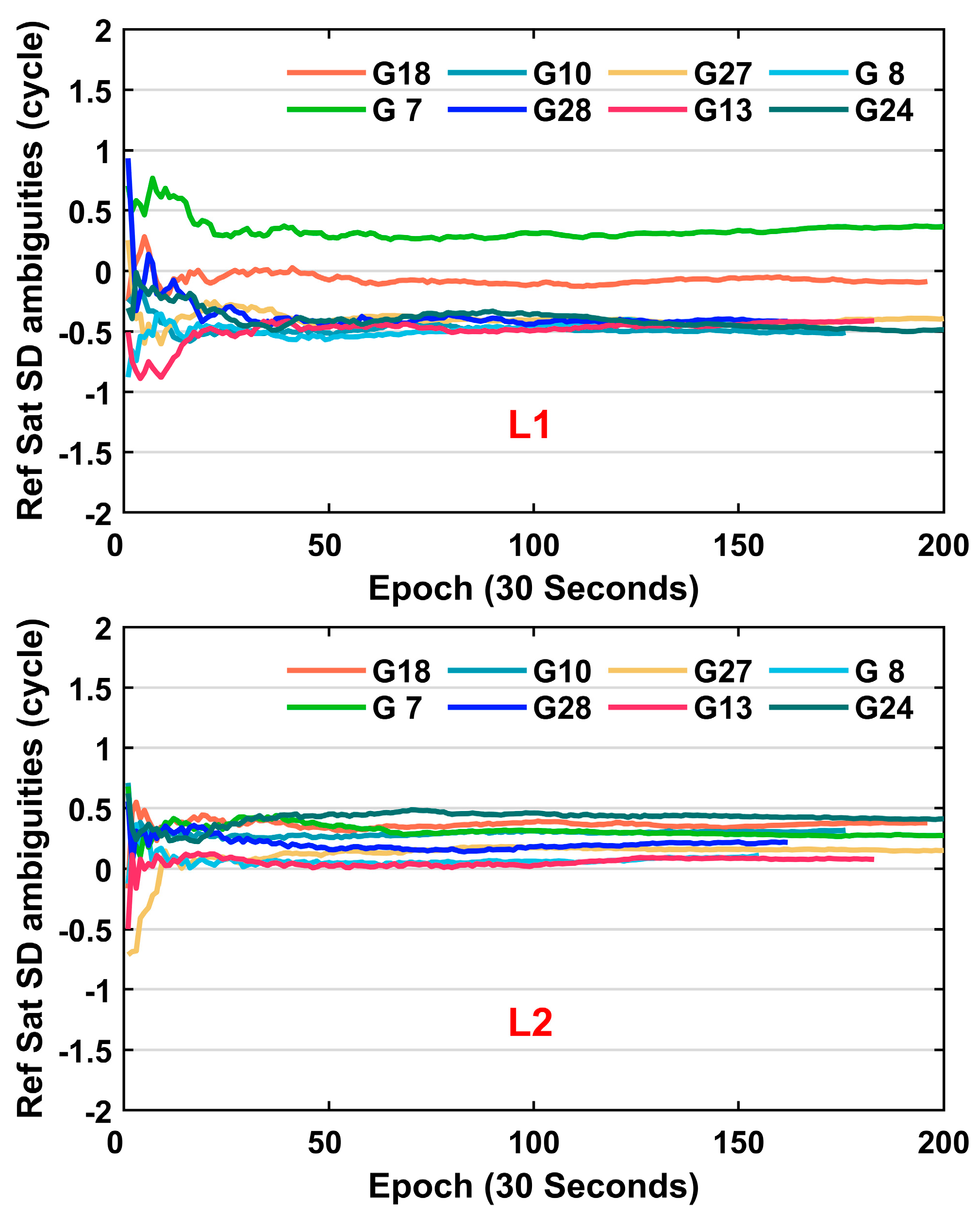
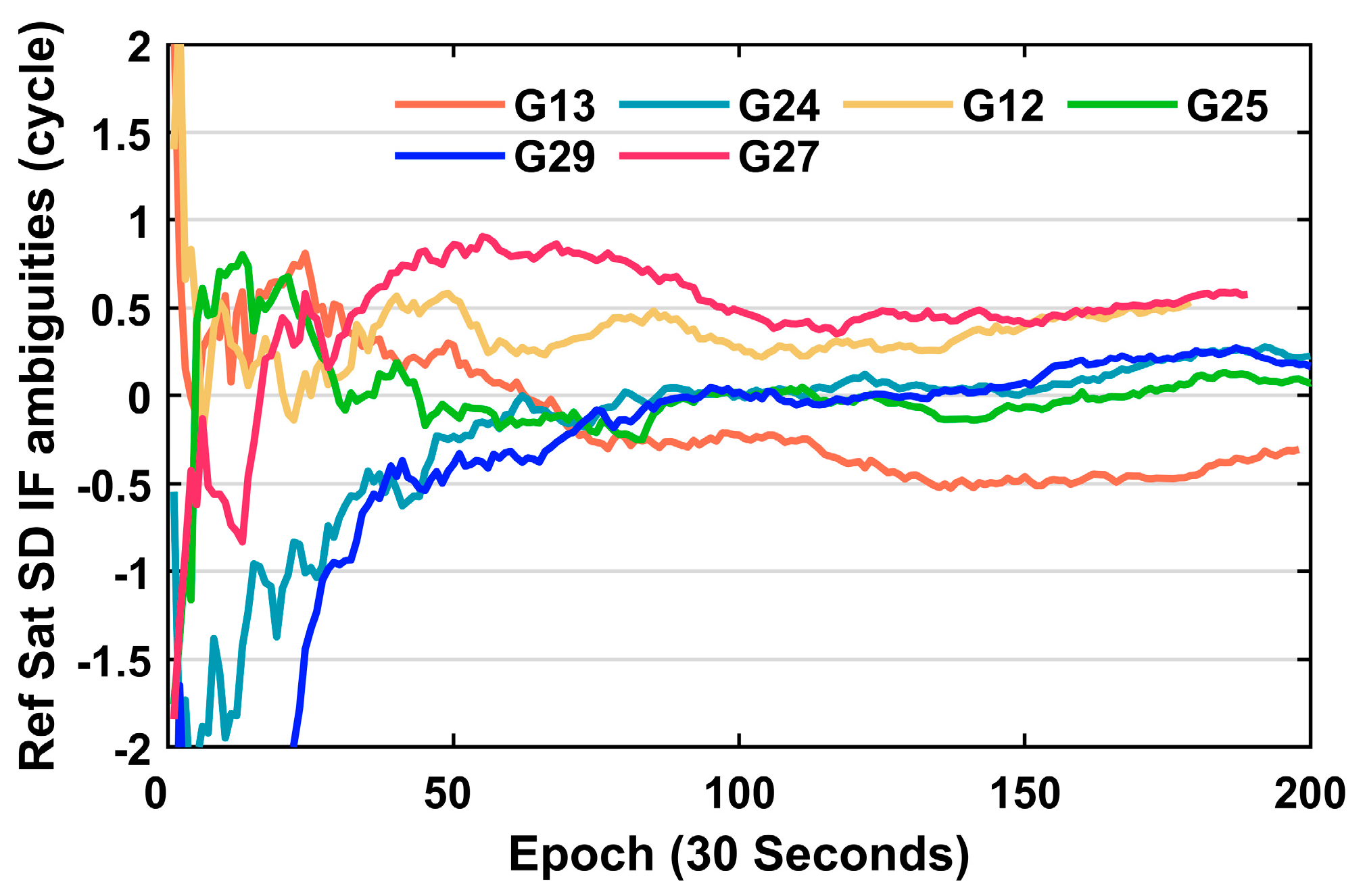
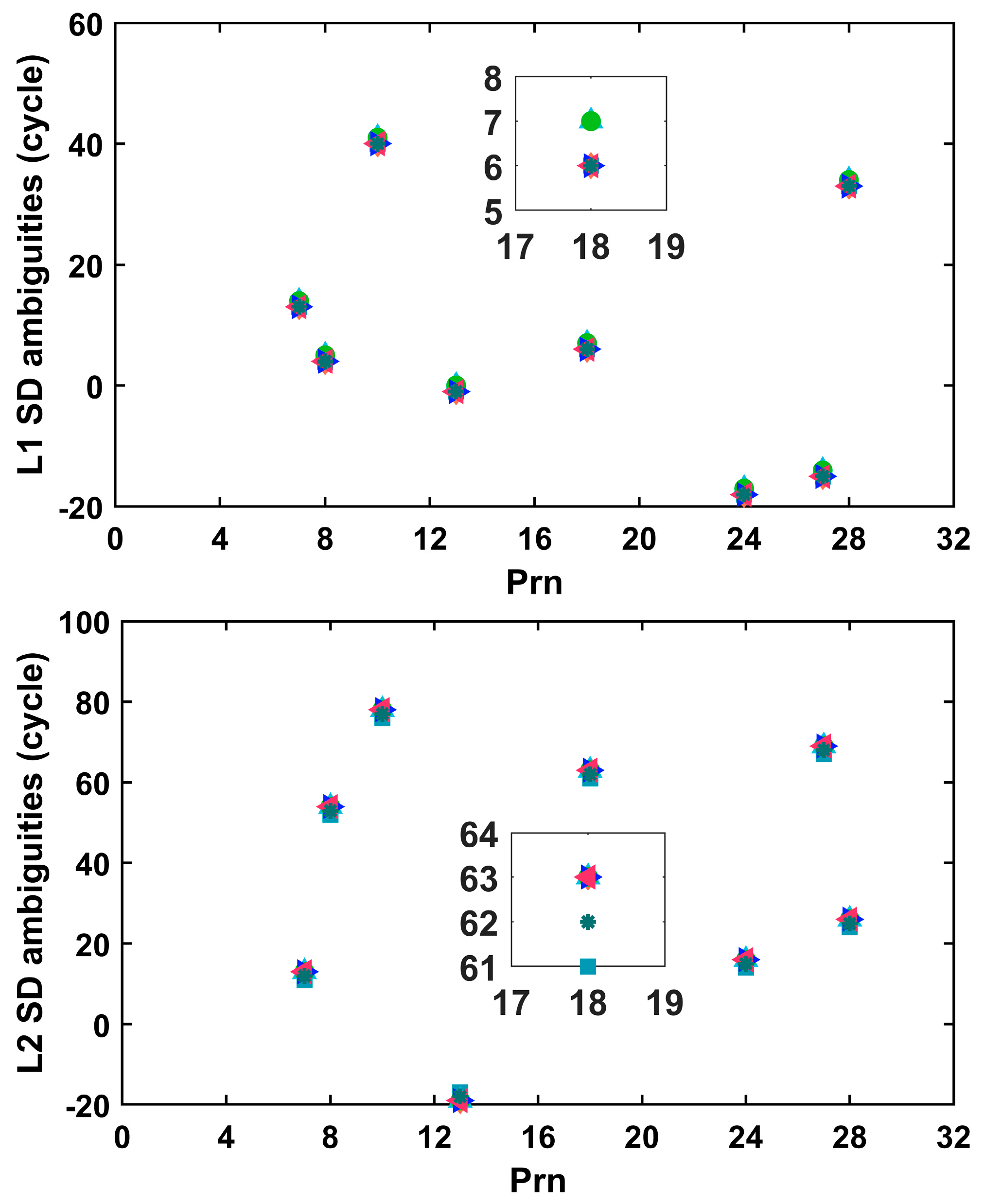
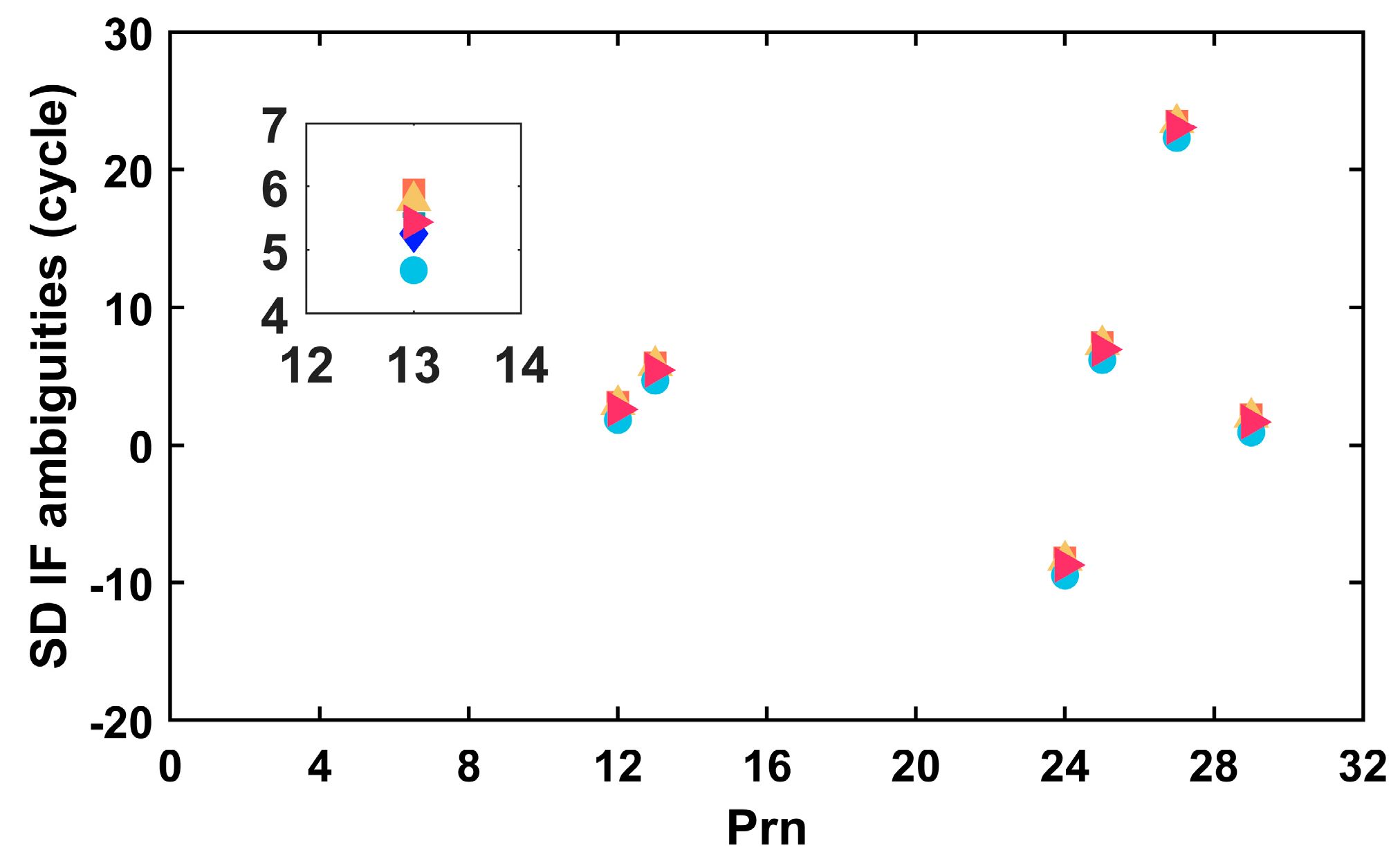
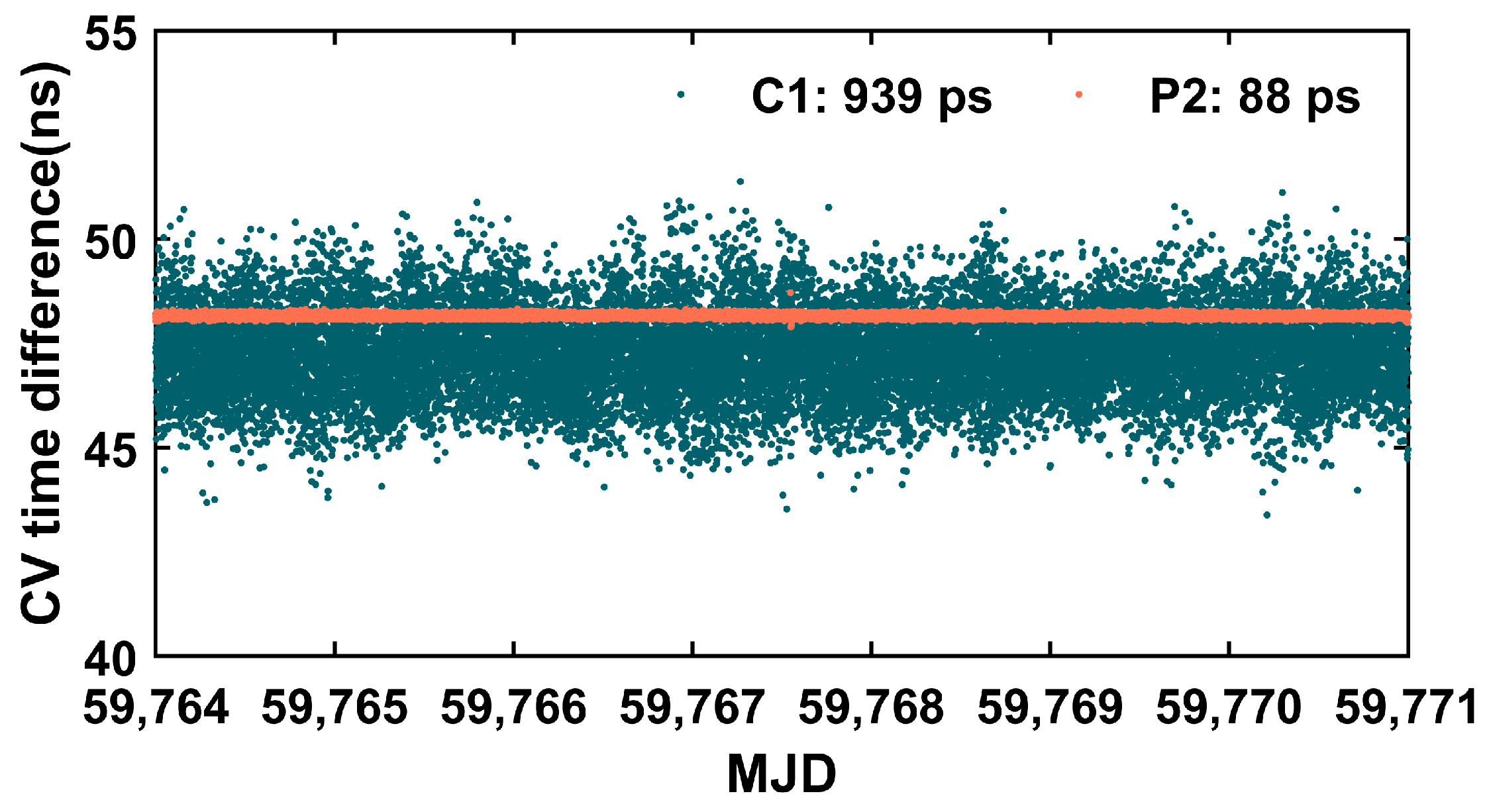

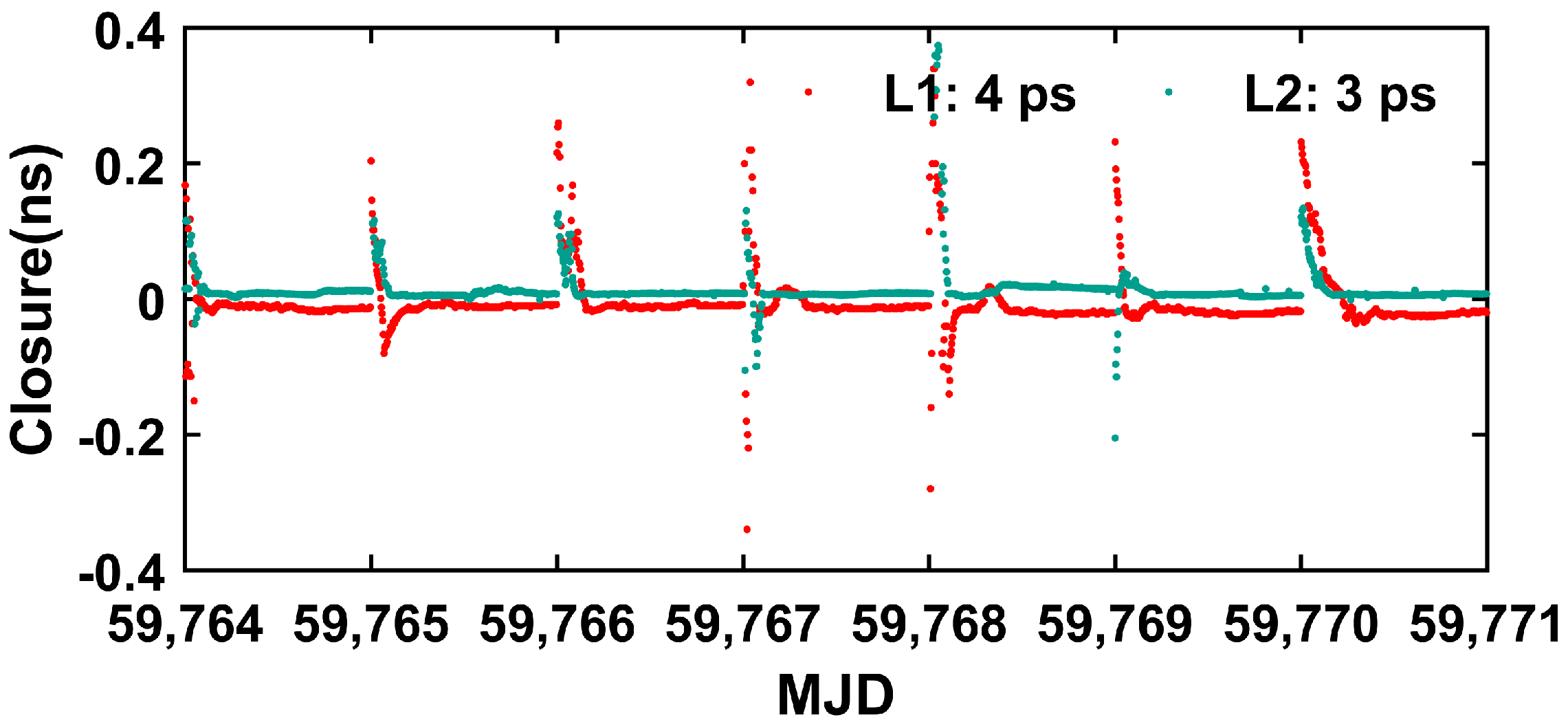
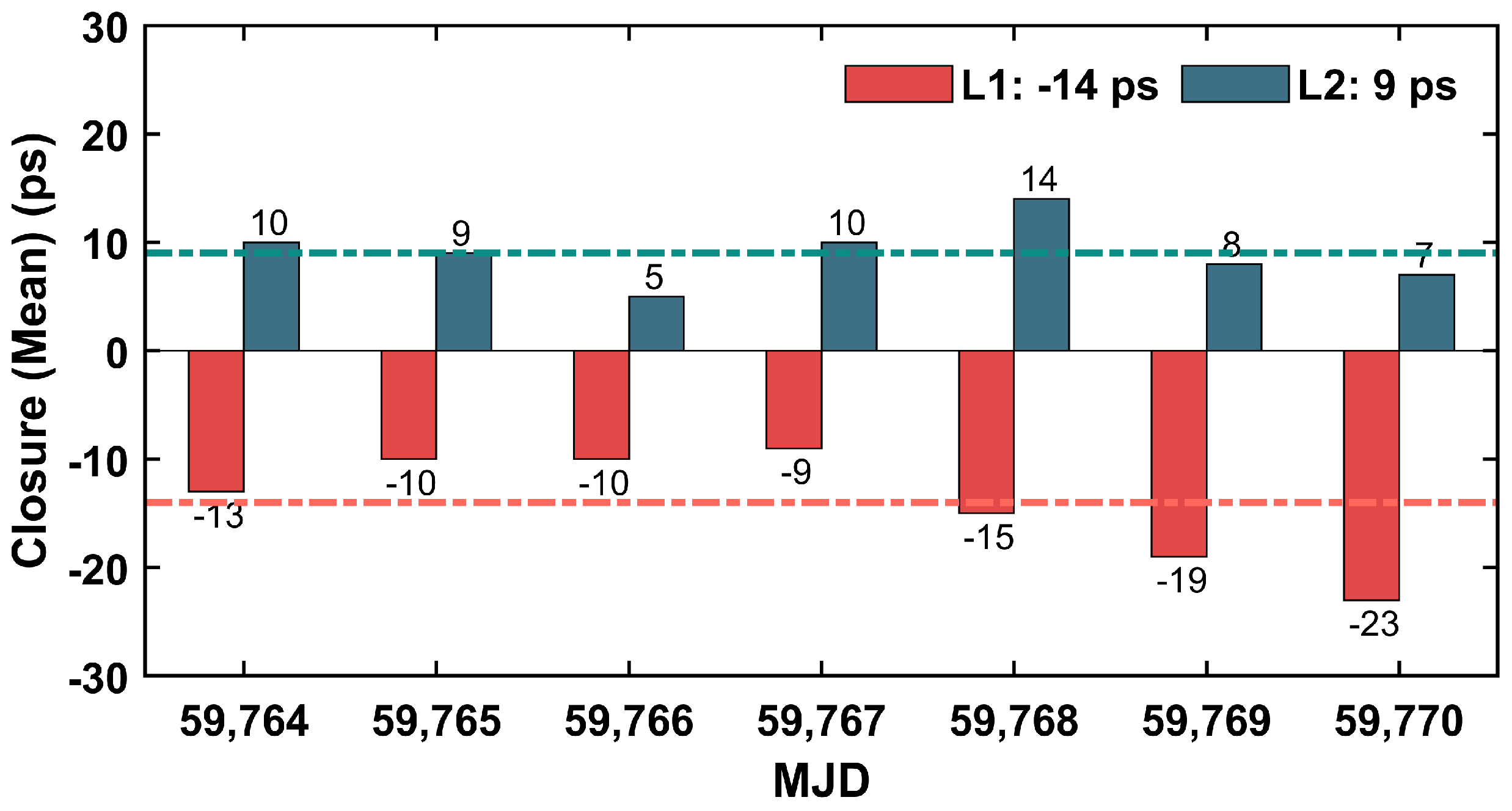
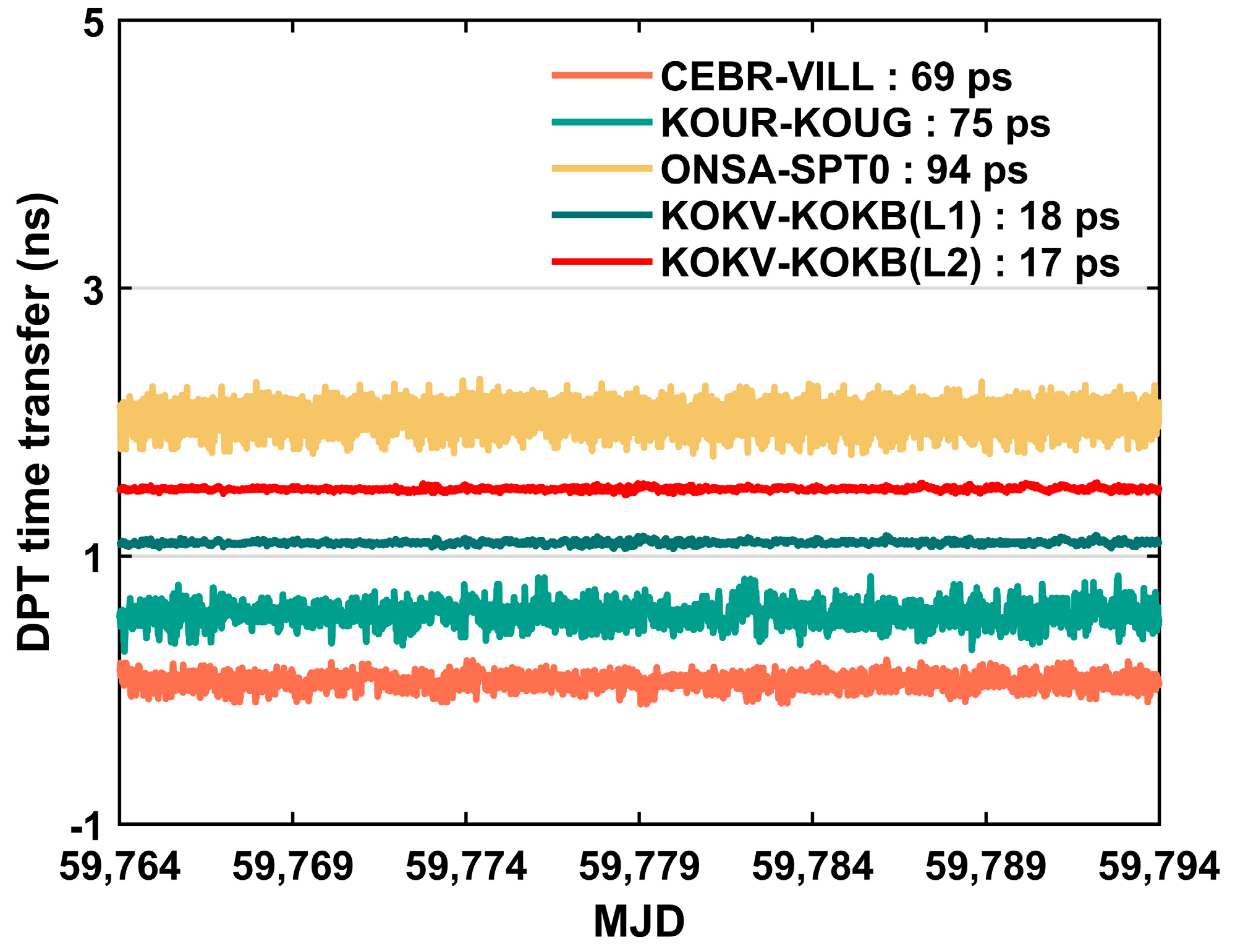
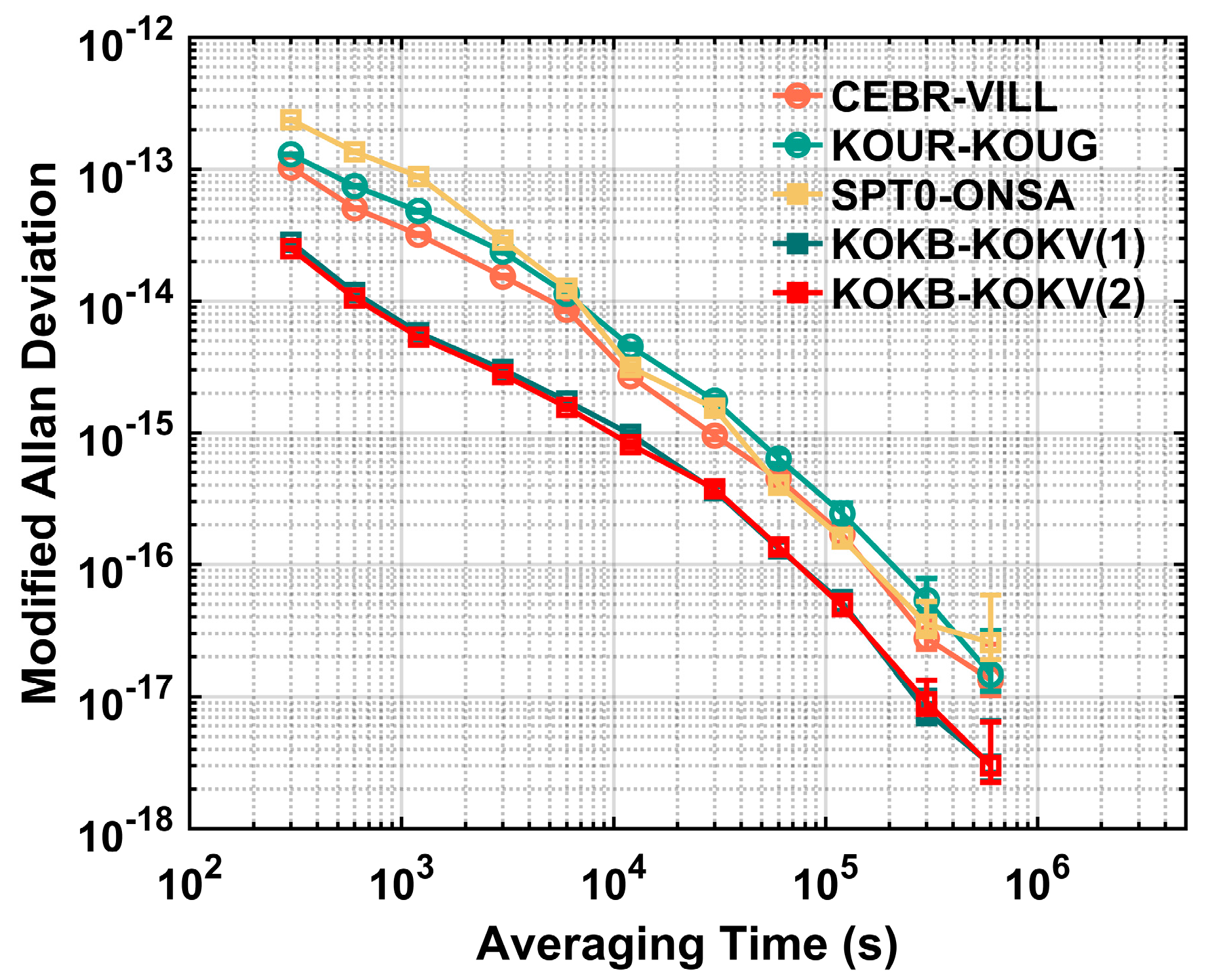
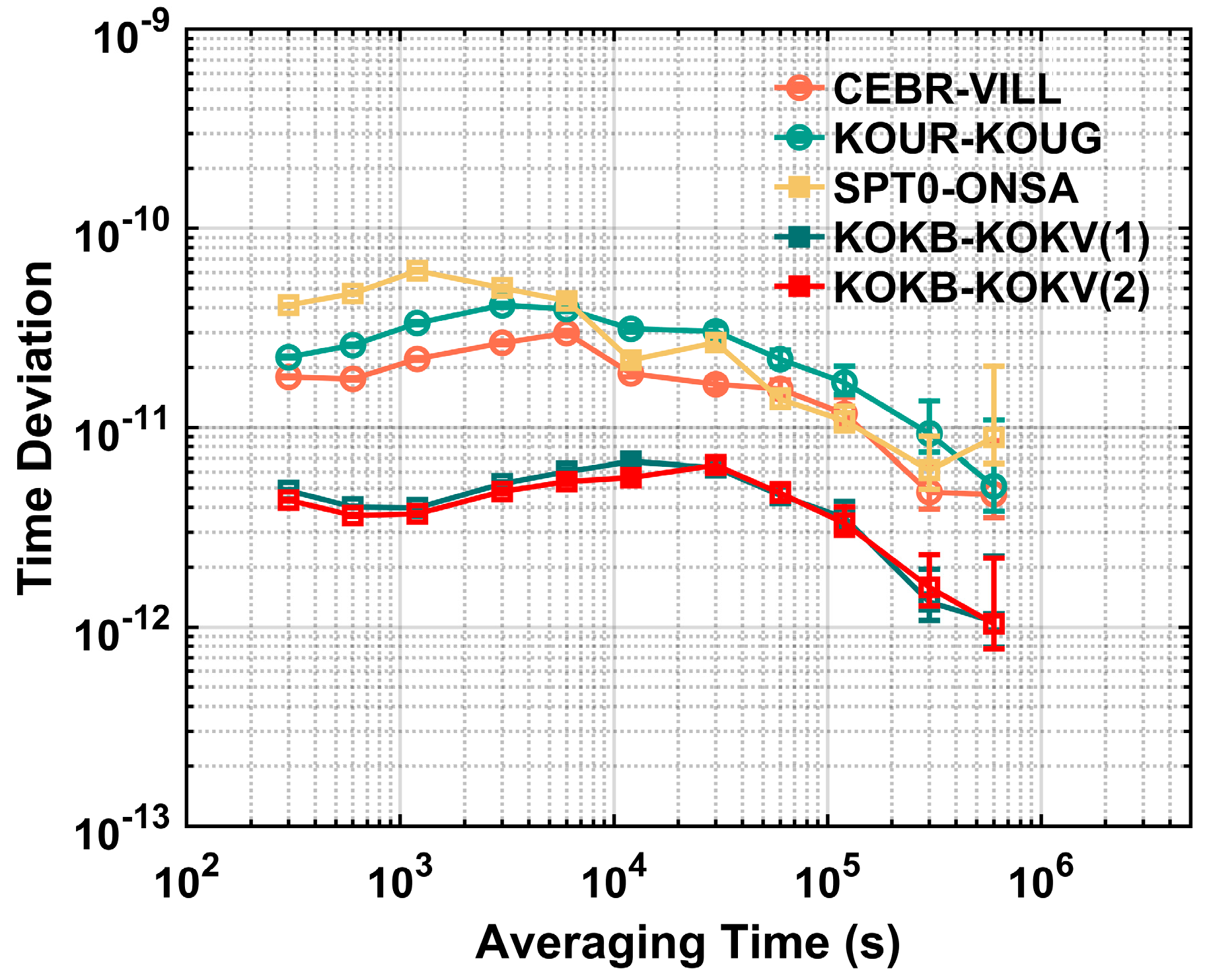
| Baseline | Receiver (B) | Antenna (B) | Receiver (U) | Antenna (U) | Distance (km) |
|---|---|---|---|---|---|
| USN7-USN8 | SEPT POLARX5TR | TPSCR.G5 | SEPT POLARX5TR | TPSCR.G5 | 0 |
| NYA1-NYA2 | TRIMBLE NETR8 | ASH701073.1 | SEPT POLARX5 | JAVRING ANT_G5T | 0.17 |
| NYA2-NYAL | SEPT POLARX5 | JAVRINGANT_G5T | TRIMBLE NETR9 | AOAD/M_B | 0.16 |
| NYAL-NYA1 | TRIMBLE NETR9 | AOAD/M_B | TRIMBLE NETR8 | ASH701073.1 | 0.007 |
| KOKV-KOVB | JAVAD TRE_G3TH DELTA | ASH701945G_M | SEPT POLARX5TR | ASH7019 45G_M | 0 |
| CEBR-VILL | SEPT POLARX5TR | SEPCHO KE_B3E6 | SEPT POLARX5 | SEPCHO KE_B3E6 | 35.30 |
| KOUR-KOUG | SEPT POLARX5TR | LEIAR25.R3 | SEPT POLARX5 | SEPCHO KE_B3E6 | 25.07 |
| ONSA-SPT0 | SEPT POLARX5TR | AOAD/M_B | SEPT POLARX5TR | TRM59800.00 | 67.90 |
| Item | Data Processing |
|---|---|
| Observation types | GPS L1, L2, C1, P2 |
| Sample rate | 30 s |
| Data period | 30 days, from Modified Julian Date (MJD) 59,764.0–59,793.0 |
| Tropospheric delay | Saastamoinen (dual frequency) |
| Ionospheric delay | IGS global ionosphere maps (single frequency) IF combination (dual frequency) |
| Cut-off angle | 10° |
| Station | TOT (C1) | TOT (P2) | Calibration Uncertainties |
|---|---|---|---|
| USN7 | 155.6 | 149.3 | 1.2 |
| USN8 | 202.6 | 197.4 | 1.2 |
| MJD | CV Time Transfer | DPT Time Transfer | ||||||
|---|---|---|---|---|---|---|---|---|
| Mean_C1 | Mean_P2 | STD_C1 | STD_P2 | Mean_L1 | Mean_L2 | STD_L1 | STD_L2 | |
| 59,764 | 292 | 64 | 1009 | 99 | 257 | 65 | 12 | 4 |
| 59,765 | 349 | 64 | 952 | 97 | 255 | 65 | 10 | 4 |
| 59,766 | 317 | 64 | 875 | 96 | 254 | 65 | 10 | 3 |
| 59,767 | 322 | 64 | 996 | 87 | 327 | 64 | 14 | 4 |
| 59,768 | 264 | 62 | 976 | 89 | 323 | 64 | 12 | 4 |
| 59,769 | 304 | 61 | 890 | 86 | 324 | 65 | 12 | 5 |
| 59,770 | 321 | 63 | 899 | 91 | 321 | 64 | 12 | 4 |
Disclaimer/Publisher’s Note: The statements, opinions and data contained in all publications are solely those of the individual author(s) and contributor(s) and not of MDPI and/or the editor(s). MDPI and/or the editor(s) disclaim responsibility for any injury to people or property resulting from any ideas, methods, instructions or products referred to in the content. |
© 2023 by the authors. Licensee MDPI, Basel, Switzerland. This article is an open access article distributed under the terms and conditions of the Creative Commons Attribution (CC BY) license (https://creativecommons.org/licenses/by/4.0/).
Share and Cite
Song, W.; Zheng, F.; Wang, H.; Shi, C. 100 Picosecond/Sub-10−17 Level GPS Differential Precise Time and Frequency Transfer. Appl. Sci. 2023, 13, 10694. https://doi.org/10.3390/app131910694
Song W, Zheng F, Wang H, Shi C. 100 Picosecond/Sub-10−17 Level GPS Differential Precise Time and Frequency Transfer. Applied Sciences. 2023; 13(19):10694. https://doi.org/10.3390/app131910694
Chicago/Turabian StyleSong, Wei, Fu Zheng, Haoyuan Wang, and Chuang Shi. 2023. "100 Picosecond/Sub-10−17 Level GPS Differential Precise Time and Frequency Transfer" Applied Sciences 13, no. 19: 10694. https://doi.org/10.3390/app131910694
APA StyleSong, W., Zheng, F., Wang, H., & Shi, C. (2023). 100 Picosecond/Sub-10−17 Level GPS Differential Precise Time and Frequency Transfer. Applied Sciences, 13(19), 10694. https://doi.org/10.3390/app131910694






